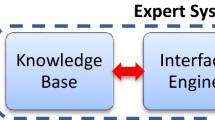Abstract
Information Technology (IT) has been extensively used to predict, visualize, and analyze physical parameters in order to expedite routine geotechnical design procedures. This paper presents an example of the combined technique of IT and numerical analysis for routine geotechnical design projects. The proposed approach involves the development of ANN(s) using a calibrated finite element model(s) for use as a prediction tool and implementation of the developed ANN(s) into a GIS platform for visualization and analysis of spatial distribution of predicted results. A novel feature of the proposed approach is an ability to expedite a routine geotechnical design process that otherwise requires significant time and effort in performing numerical analyses for different design scenarios. A knowledge-based underground excavation design system that utilizes artificial neural networks (ANNs) as prediction tools is also introduced. Practical implications of the use of IT in geotechnical design are discussed in great detail.


















Similar content being viewed by others
References
Abaqus 6.7 (2007) Hibbitt, Karlsson, and Sorensen, Pawtucket, Providence, RI
Beer G (2003) Numerical simulation in tunnelling. Springer, New York
Demuth H, Beale M (1997) Neural network toolbox user’s guide. The Mathworks Inc., Natic
GEODATA Geoengineering Consultants (2010) Citing Website, Retrived 2010, from http://www.geodata.it
Itasca Consulting Group (2001) FLAC-fast Lagrangian analysis of continua. Version 4.00. Itasca Consulting Group Inc., Minneapolis, Minn
Netzel H, Kallberg FJ (1999) Numerical damage risk assessment studies on masonry structures due to TBM-tunnelling in Amsterdam. In: Proceedings geotechnical aspects on underground construction in soft ground, Tokyo, Japan. pp 235–244
Rumelhart DE, Honton GE, Williams RJ (1986) Learning internal representation by error propagation. In: Rumelhart and McClelland (ed) Parallel distributed processing. vol 1, Chap 8, MIT Press, Cambridge, MA
Shahin MA, Maier HR, Jaksa MB (2002) Predicting settlement of shallow foundations using neural networks. J Geotech Geoenviron Eng 128(9):285–793
Xie M, Esaki T, Zhou G, Mitani Y (2003) Geographical information systems-based three-dimensional critical slope stability analysis and landslide hazard assessment. J Geotech Geoenviron Eng 129(12):1109–1118
Xie M, Esaki T, Cai M (2006) GIS-BAsed implementation of three-dimensional limit equilibrium approach of slope stability. J Geotech Geoenviron Eng 132(5):656–660
Yoo C (2010) Integration of IT into routine geotechnical design. In: Proceedings of the 1st international conference on information technology in Geo-Engineering, Shanghai, China, pp 11–20
Yoo C, Kim JH (2003) A Web-based tunnelling-induced building/utility damage assessment system: TURISK. Tunn Undergr Space Technol 18(5):497–511
Yoo C, Kim JM (2007) Tunneling performance prediction using an integrated GIS and neural network. Comput Geotech 34(1):19–30
Yoo C, Kim JW (2010) GIS-ANN based soft ground improvement design-concept and implementation. In: Proceedings of the new frontiers in computational geotechnics 2010, Zhang Lin, Yahima (ed.), Pittsburgh, USA, pp 145–148
Yoo C, Kim JH, Park YJ, Yoo JH (2002) A GIS-based tunneling-induced building/utility damage assessment system-development. In: Proceedings of ITA world tunneling congress 2003, Saveur (ed). Amsterdam, The Netherlands, pp 1079–1087
Yoo C, Kim SB, Jung HY, Kim JM (2004) Tunnel construction risk assessment for Seoul-Pusan high-speed railway contract 14-3 Tunnel Design Project, Report to Hyundai Engineering and Construction Co., Ltd
Yoo C, Kim SB, Jung HY (2005) GIS-ANN based soft ground improvement design for Gwang-Yang area, report to ESCO consultant
Yoo C, Jeon YW, Choi BS (2006) IT-based tunnelling risk management system (IT-TURISK)—development and implementation. Tunn Undergr Space Technol 21(2):190–202
Yoo C, You K, Park IJ (2010) Development and implementation of knowledge-based underground excavation design system. Int J Geo-Engin 1(2):19–30
Acknowledgments
This research is supported by Grant No. 10CCTI-E09 from the Ministry of Land, Transport and Maritime Affairs, Korea and by Grant No. 20100008227 from the Basic Research Program of the Korea Science & Engineering Foundation. The financial support is gratefully acknowledged.
Author information
Authors and Affiliations
Corresponding author
Rights and permissions
About this article
Cite this article
Yoo, C. Integration of Information Technology into Geotechnical Engineering Practice: Concept and Development. Geotech Geol Eng 31, 965–978 (2013). https://doi.org/10.1007/s10706-012-9587-1
Received:
Accepted:
Published:
Issue Date:
DOI: https://doi.org/10.1007/s10706-012-9587-1




